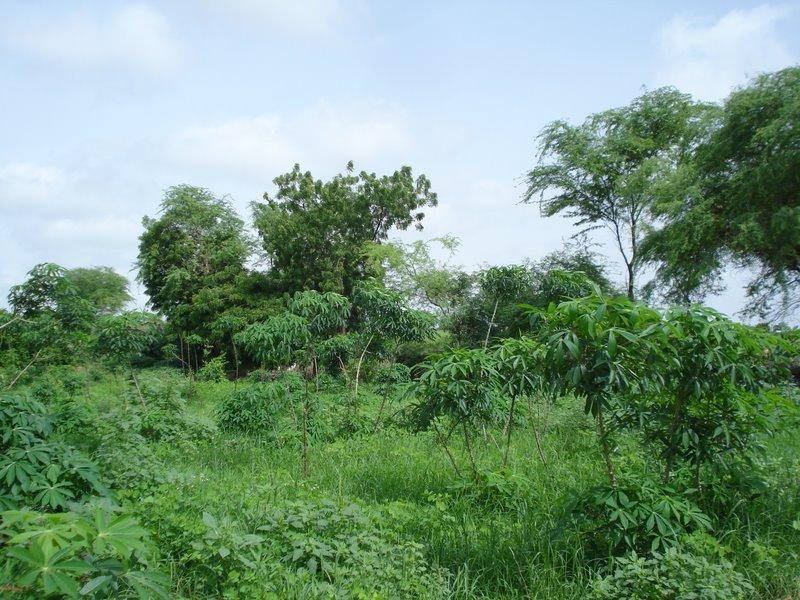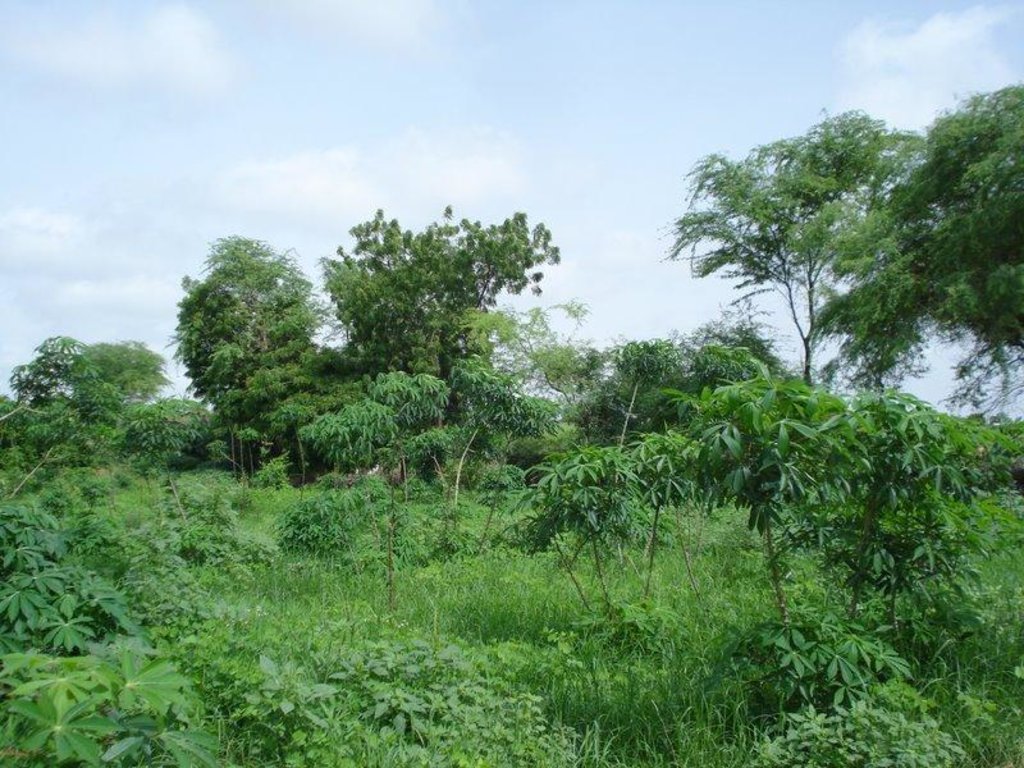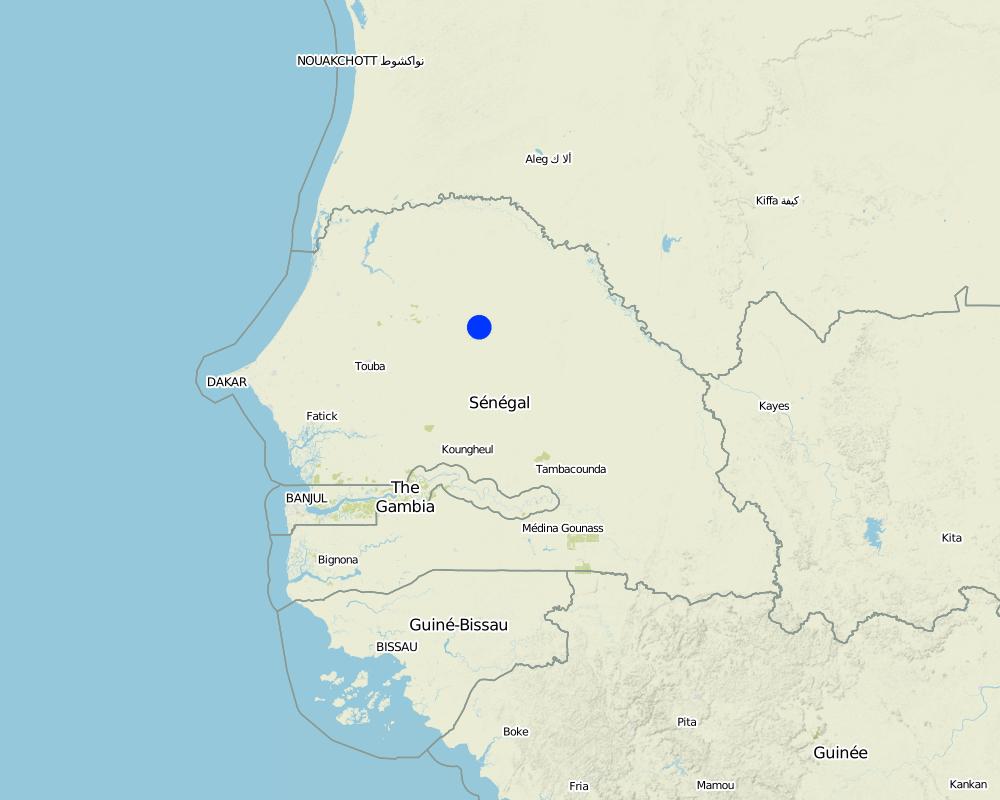Agroforestry homegarden [Senegal]
- Creation:
- Update:
- Compiler: Julie Zähringer
- Editor: –
- Reviewer: Fabian Ottiger
technologies_1166 - Senegal
View sections
Expand all Collapse all1. General information
1.2 Contact details of resource persons and institutions involved in the assessment and documentation of the Technology
SLM specialist:
Name of the institution(s) which facilitated the documentation/ evaluation of the Technology (if relevant)
CDE Centre for Development and Environment (CDE Centre for Development and Environment) - SwitzerlandName of the institution(s) which facilitated the documentation/ evaluation of the Technology (if relevant)
CSE (CSE) - Senegal1.3 Conditions regarding the use of data documented through WOCAT
When were the data compiled (in the field)?
07/08/2009
The compiler and key resource person(s) accept the conditions regarding the use of data documented through WOCAT:
Yes
2. Description of the SLM Technology
2.1 Short description of the Technology
Definition of the Technology:
A tropical homegarden of about 0.5 ha with a variety of exotic and indigenous tree species, planted or raised for fruit production, medicinal value and / or other services, intercropped with vegetables in the herbaceous layer.
2.2 Detailed description of the Technology
Description:
During the dry season, tomato, eggplant, chili, beans, cabbage, okra and bissap are cultivated, in the rainy season replaced with maïz. One part of the garden is cultivated with cassava, planted in the rainy season and harvested all year round. Main tree species are Prosopis juliflora, Citrus sp. and Eucalyptus camaldulensis. A hedge of mainly dead wood, alive Euphorbia balsamifera shrubs and few Eucalyptus camaldulensis trees is protecting the homegarden from roaming animals. It has the positive off-site effect of preventing the temporary pond beneath the plot from being filled up with sediments, as a consequence of wind erosion. Organic manure obtained from cattle faeces is used as a natural fertilizer.
Purpose of the Technology: The garden was established and is managed by a single land user and his family. Main objectives are to provide food security for his family, to make a wide range of fruits and vegetables available in a zone far from the next market and to improve income through diversification. As the plot is situated on a slope (7 %) and prone to water erosion during heavy rains, a further objective is to prevent the formation of gullies and ravines through better soil stabilization.
Establishment / maintenance activities and inputs: Trees planted in this plot were chosen upon seed or seedling availability in other peoples land as the land user planted whatever he could obtain. He constructed a fence of dead wood with the aim to turn it into a life fence of Eucalyptus camaldulensis trees later. A small retention basin was built to assure the storage of water tapped from the village borehole. However, because of breakdowns of the pump and the generally low outflow of the borehole, lack of water caused high mortality in the tree nursery of Eucalyptus camaldulensis seedlings. The fence therefore remains a mainly dead fence and is very weak in certain places. The main cost of the technology is the access to the borehole which costs the landuser 20'000 CFA (US-Dollar 45) per month. For the purchase of seeds for horticulture about 15'000 CFA (US-Dollar 33.50) are spent per year. The use of organic manure does not involve any costs as cattle is abundant in the area.
Natural / human environment: This SLM technology site is located in the sylvopastoral region of the Ferlo in the north of Sénégal. The agro-climatic zone is classified as semi-arid with mean annual precipitation of 300-400 mm. The main land use type in the area is extensive pastoralism followed by rainfed agriculture. Pastoralism is primarily practiced by transhumant Fula (Peulh) herders and further by Mauritanian Moor herders with herds of dromedaries. Vegetation cover in the area has largely been degraded due to cutting for domestic uses and cattle feeding, bushfires and overgrazing. The soil is exposed to wind erosion which carries away nutrients in the topsoil and therefore declines soil fertility. During intense rains in the rainy season, surface runoff is accelerated and leads to the formation of gullies and ravines.
2.3 Photos of the Technology
2.5 Country/ region/ locations where the Technology has been applied and which are covered by this assessment
Country:
Senegal
Region/ State/ Province:
Louga / Linguère
Further specification of location:
Barkédji / Diagali
Map
×2.6 Date of implementation
If precise year is not known, indicate approximate date:
- less than 10 years ago (recently)
2.7 Introduction of the Technology
Specify how the Technology was introduced:
- through land users' innovation
3. Classification of the SLM Technology
3.1 Main purpose(s) of the Technology
- improve production
- create beneficial economic impact
- create beneficial social impact
3.2 Current land use type(s) where the Technology is applied

Mixed (crops/ grazing/ trees), incl. agroforestry
- Agroforestry
Main products/ services:
Maïz, manioc
Comments:
Major land use problems (compiler’s opinion): degradation of vegetation cover, wind erosion, increased surface runoff, formation of gullies and ravines, management of natural water sources (people using temporary ponds for laundry and body hygiene and at the same time as sources of drinking water)
Major land use problems (land users’ perception): surface runoff, formation of gullies and ravines, decrease of soil fertility, wind erosion, limited water access, presence of insect pests
3.3 Further information about land use
Comments:
Water supply: rainfed, mixed rainfed - irrigated
Number of growing seasons per year:
- 1
Specify:
Longest growing period in days: 120Longest growing period from month to month: Jul-Oct
3.4 SLM group to which the Technology belongs
- agroforestry
- windbreak/ shelterbelt
- rotational systems (crop rotation, fallows, shifting cultivation)
3.5 Spread of the Technology
Specify the spread of the Technology:
- evenly spread over an area
If the Technology is evenly spread over an area, indicate approximate area covered:
- < 0.1 km2 (10 ha)
Comments:
The surface of this homegarden is about 0.5 ha
3.6 SLM measures comprising the Technology

agronomic measures
- A2: Organic matter/ soil fertility

vegetative measures
- V1: Tree and shrub cover
Comments:
Main measures: vegetative measures
Secondary measures: agronomic measures
Type of agronomic measures: retaining more vegetation cover, manure / compost / residues
Type of vegetative measures: scattered / dispersed
3.7 Main types of land degradation addressed by the Technology

soil erosion by water
- Wg: gully erosion/ gullying

soil erosion by wind
- Et: loss of topsoil
- Eo: offsite degradation effects

biological degradation
- Bs: quality and species composition/ diversity decline
Comments:
Main type of degradation addressed: Wg: gully erosion / gullying, Bs: quality and species composition /diversity decline
Secondary types of degradation addressed: Et: loss of topsoil, Eo: offsite degradation effects
Main causes of degradation: deforestation / removal of natural vegetation (incl. forest fires) (for domestic uses), over-exploitation of vegetation for domestic use, overgrazing (by oversized cattle and dromadaires herds), poverty / wealth (poverty), education, access to knowledge and support services
Secondary causes of degradation: soil management (absence (or insufficient use) of inorganic and organic fertilizers)
3.8 Prevention, reduction, or restoration of land degradation
Specify the goal of the Technology with regard to land degradation:
- reduce land degradation
4. Technical specifications, implementation activities, inputs, and costs
4.2 Technical specifications/ explanations of technical drawing
Technical knowledge required for field staff / advisors: (the landuser concerned does not have this level of knowledge)
Technical knowledge required for land users: moderate
Main technical functions: control of dispersed runoff: impede / retard, improvement of ground cover, stabilisation of soil (eg by tree roots against land slides), sediment retention / trapping, sediment harvesting, promotion of vegetation species and varieties (quality, eg palatable fodder)
Secondary technical functions: increase in organic matter, reduction in wind speed, increase of biomass (quantity)
Retaining more vegetation cover
Material/ species: trees
Quantity/ density: 118 / ha
Manure / compost / residues
Material/ species: organic manure
Scattered / dispersed
Vegetative material: T : trees / shrubs
Number of plants per (ha): 118
Trees/ shrubs species: Citrus sp. (planted), Eucalyptus camaldulensis (planted), Azadirachta indica (planted), Tamarindus i
4.3 General information regarding the calculation of inputs and costs
other/ national currency (specify):
CFA
Indicate exchange rate from USD to local currency (if relevant): 1 USD =:
455.0
4.4 Establishment activities
| Activity | Type of measure | Timing | |
|---|---|---|---|
| 1. | access to irrigation water for tree nursery | Vegetative | per month |
4.6 Maintenance/ recurrent activities
| Activity | Type of measure | Timing/ frequency | |
|---|---|---|---|
| 1. | seeds or seedlings for horticulture | Vegetative | once a year |
4.7 Costs and inputs needed for maintenance/ recurrent activities (per year)
| Specify input | Unit | Quantity | Costs per Unit | Total costs per input | % of costs borne by land users | |
|---|---|---|---|---|---|---|
| Plant material | Seeds | ha | 1.0 | 33.0 | 33.0 | 100.0 |
| Other | Irrigation water | ha | 1.0 | 45.0 | 45.0 | 100.0 |
| Total costs for maintenance of the Technology | 78.0 | |||||
Comments:
Costs indicated apply to an agroforestry plot of 0.5 ha surface. No costs were involved with the initial planting of trees in the plot, as seedlings were either given by the extensive agent for "Water and Forest" or obtained from other landusers. Organic manure can be obtained for free due to the strong presence of cattle in the area. For the construction of the fence, dead wood was collected in the area.
4.8 Most important factors affecting the costs
Describe the most determinate factors affecting the costs:
rainfall regime: water for irrigation needed during dry season
5. Natural and human environment
5.1 Climate
Annual rainfall
- < 250 mm
- 251-500 mm
- 501-750 mm
- 751-1,000 mm
- 1,001-1,500 mm
- 1,501-2,000 mm
- 2,001-3,000 mm
- 3,001-4,000 mm
- > 4,000 mm
Specifications/ comments on rainfall:
300-400 mm during one rainy season / length of dry season: 9 months
Agro-climatic zone
- semi-arid
Thermal climate class: tropics
5.2 Topography
Slopes on average:
- flat (0-2%)
- gentle (3-5%)
- moderate (6-10%)
- rolling (11-15%)
- hilly (16-30%)
- steep (31-60%)
- very steep (>60%)
Landforms:
- plateau/plains
- ridges
- mountain slopes
- hill slopes
- footslopes
- valley floors
Altitudinal zone:
- 0-100 m a.s.l.
- 101-500 m a.s.l.
- 501-1,000 m a.s.l.
- 1,001-1,500 m a.s.l.
- 1,501-2,000 m a.s.l.
- 2,001-2,500 m a.s.l.
- 2,501-3,000 m a.s.l.
- 3,001-4,000 m a.s.l.
- > 4,000 m a.s.l.
Comments and further specifications on topography:
Landforms: Valley floors (depression)
Slopes on average: Moderate (7%)
5.3 Soils
Soil depth on average:
- very shallow (0-20 cm)
- shallow (21-50 cm)
- moderately deep (51-80 cm)
- deep (81-120 cm)
- very deep (> 120 cm)
Soil texture (topsoil):
- coarse/ light (sandy)
Topsoil organic matter:
- low (<1%)
If available, attach full soil description or specify the available information, e.g. soil type, soil PH/ acidity, Cation Exchange Capacity, nitrogen, salinity etc.
Soil fertility: Very low
Topsoil organic matter: Low (carbon in the labile fraction: 0.09 g / kg soil)
Soil drainage/infiltration: Good
Soil water storage capacity: Low
5.4 Water availability and quality
Availability of surface water:
poor/ none
Water quality (untreated):
poor drinking water (treatment required)
Comments and further specifications on water quality and quantity:
Water quality (untreated): Poor drinking water (treatment required, ranked 1, groundwater during dry season) and for agricultural use only (irrigation, ranked 2, surface water from temporary ponds during rainy season)
5.5 Biodiversity
Species diversity:
- medium
Comments and further specifications on biodiversity:
Compared to other regions of the country
5.6 Characteristics of land users applying the Technology
Market orientation of production system:
- mixed (subsistence/ commercial
Off-farm income:
- 10-50% of all income
Relative level of wealth:
- average
Individuals or groups:
- individual/ household
Level of mechanization:
- manual work
Gender:
- men
Indicate other relevant characteristics of the land users:
Land users applying the Technology are mainly common / average land users
Difference in the involvement of women and men: women can not aquire land to cultivate unless it is attributed to them by their husbands
Population density: < 10 persons/km2
Annual population growth: 2% - 3%
22% of the land users are average wealthy.
5.7 Average area of land owned or leased by land users applying the Technology
- < 0.5 ha
- 0.5-1 ha
- 1-2 ha
- 2-5 ha
- 5-15 ha
- 15-50 ha
- 50-100 ha
- 100-500 ha
- 500-1,000 ha
- 1,000-10,000 ha
- > 10,000 ha
Is this considered small-, medium- or large-scale (referring to local context)?
- small-scale
Comments:
Apart from the plot the landuser is cultivating some village fields
5.8 Land ownership, land use rights, and water use rights
Land ownership:
- state
- individual, not titled
Land use rights:
- communal (organized)
Water use rights:
- communal (organized)
5.9 Access to services and infrastructure
health:
- poor
- moderate
- good
education:
- poor
- moderate
- good
technical assistance:
- poor
- moderate
- good
employment (e.g. off-farm):
- poor
- moderate
- good
markets:
- poor
- moderate
- good
energy:
- poor
- moderate
- good
roads and transport:
- poor
- moderate
- good
drinking water and sanitation:
- poor
- moderate
- good
financial services:
- poor
- moderate
- good
6. Impacts and concluding statements
6.1 On-site impacts the Technology has shown
Socio-economic impacts
Production
product diversity
production area
Water availability and quality
demand for irrigation water
Income and costs
farm income
diversity of income sources
Socio-cultural impacts
food security/ self-sufficiency
Improved livelihoods and human well-being
Comments/ specify:
Increased food security, improved diversification of alimentation
Ecological impacts
Water cycle/ runoff
surface runoff
evaporation
Soil
soil cover
Biodiversity: vegetation, animals
biomass/ above ground C
plant diversity
Climate and disaster risk reduction
emission of carbon and greenhouse gases
wind velocity
6.2 Off-site impacts the Technology has shown
downstream siltation
wind transported sediments
6.3 Exposure and sensitivity of the Technology to gradual climate change and climate-related extremes/ disasters (as perceived by land users)
Gradual climate change
Gradual climate change
| Season | Type of climatic change/ extreme | How does the Technology cope with it? | |
|---|---|---|---|
| annual temperature | increase | well |
Climate-related extremes (disasters)
Meteorological disasters
| How does the Technology cope with it? | |
|---|---|
| local rainstorm | not well |
| local windstorm | not known |
Climatological disasters
| How does the Technology cope with it? | |
|---|---|
| drought | not well |
Hydrological disasters
| How does the Technology cope with it? | |
|---|---|
| general (river) flood | not well |
Other climate-related consequences
Other climate-related consequences
| How does the Technology cope with it? | |
|---|---|
| reduced growing period | not well |
6.4 Cost-benefit analysis
How do the benefits compare with the establishment costs (from land users’ perspective)?
Short-term returns:
positive
Long-term returns:
very positive
How do the benefits compare with the maintenance/ recurrent costs (from land users' perspective)?
Short-term returns:
positive
6.5 Adoption of the Technology
- single cases/ experimental
Of all those who have adopted the Technology, how many have did so spontaneously, i.e. without receiving any material incentives/ payments?
- 90-100%
Comments:
100% of land user families have adopted the Technology without any external material support
There is a strong trend towards spontaneous adoption of the Technology
Comments on adoption trend: many inhabitants of this village try to establish similar plots
6.7 Strengths/ advantages/ opportunities of the Technology
| Strengths/ advantages/ opportunities in the land user’s view |
|---|
| increase of product diversification, availability of vegetables in village |
|
increase of revenues How can they be sustained / enhanced? increase production and fight against soil fertility decline |
| increased food security |
| increased availability of plants used in traditional medicine |
|
mitigation of gully formation How can they be sustained / enhanced? improve strenght of fence |
| Strengths/ advantages/ opportunities in the compiler’s or other key resource person’s view |
|---|
|
increased woody plant diversity and density How can they be sustained / enhanced? maintain trees in plot |
|
the fence reduces siltation of the village's most important temporary pond beneath the plot How can they be sustained / enhanced? improve the fence with live trees |
6.8 Weaknesses/ disadvantages/ risks of the Technology and ways of overcoming them
| Weaknesses/ disadvantages/ risks in the land user’s view | How can they be overcome? |
|---|---|
| outflow of village borehole too weak to maintain irrigation of seedlings in tree nursery and vegetables | better maintenance of borehole |
| high mortality in tree nursery because insufficience of water | improve access to water from borehole |
| Weaknesses/ disadvantages/ risks in the compiler’s or other key resource person’s view | How can they be overcome? |
|---|---|
| use of chemical pesticides against soil insects which are believed to be a cause for decline in soil fertility | research to know more about cause of fertility decline or use of biological pesticides |
| degradation of soil properties because of inappropriate soil management in parts of the plot | training in soil management for landuser |
| removal of herbaceous cover to gain space for cultivation | training |
| no system applied to distribution of trees in the field | apply structural soil conservation measures, such as terraces etc. |
| gully formation because of slope and weak fence threatens future maintenance of plot |
Links and modules
Expand all Collapse allLinks
No links
Modules
No modules




